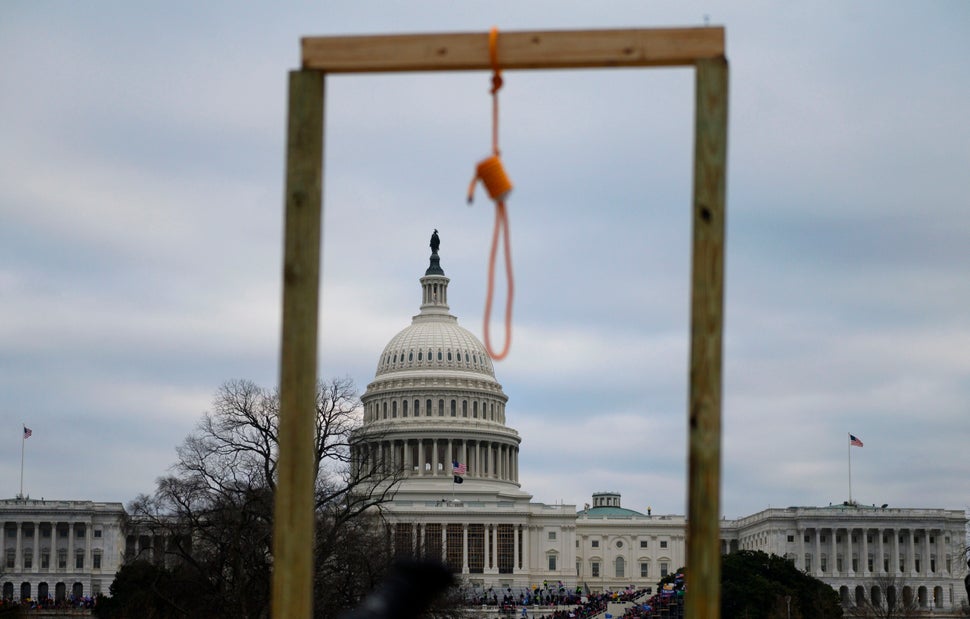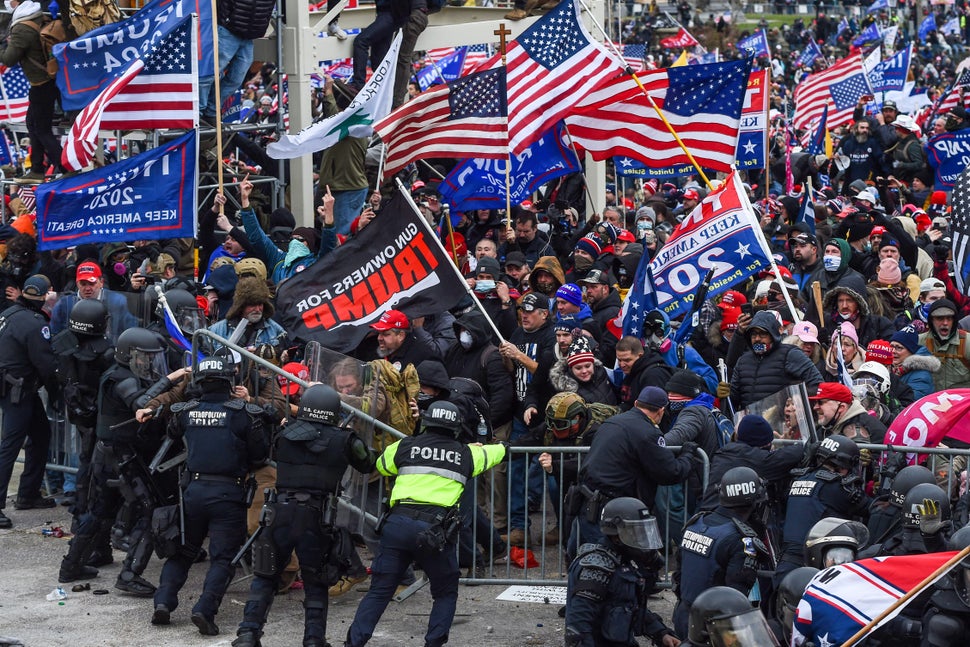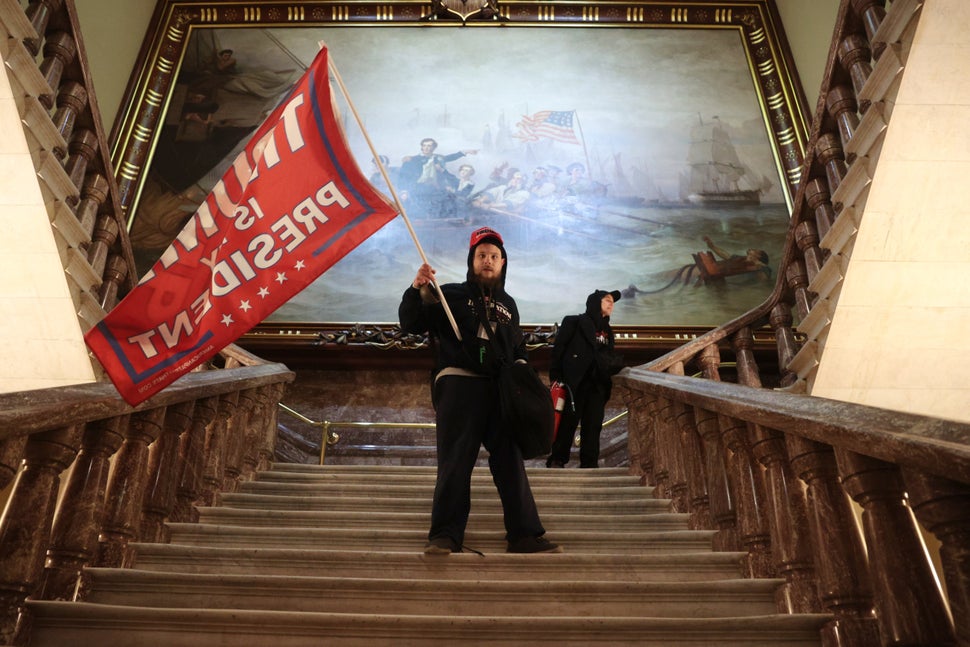[ad_1]
A deranged mob of Americans, fueled by lies about election fraud peddled by the president of the United States along with multiple senators and House members, sacked the U.S. Capitol on Wednesday as part of an insurrection encouraged by Donald Trump to stop the constitutional process allowing for the peaceful transfer of power taking place within the building.
“[Y]ou’ll never take back your country with weakness,” Trump told the rioters immediately before they marched on the Capitol. “You have to show strength and be strong.”
“We’re going to try to give our Republicans — the weak ones, because the strong ones don’t need any of our help — we’re going to try and give them [the] kind of pride and boldness they need to take back our country,” he said to the crowd on the National Mall.
The ensuing riot led members of Congress to flee in gas masks after police deployed tear gas as an armed standoff took place between U.S. Capitol Police and rioters at the doors of the House Chamber. Confederate flags were paraded through the halls of Congress as rioters donned in tactical military gear and carrying zip-tie handcuffs, likely intended to be used to kidnap lawmakers, entered the Senate chamber. They screamed for Mike Pence’s head after Trump denounced his own vice president in an audio message. Some wore sweatshirts bearing the message: “MAGA Civil War” and the date, “1.6.21.”
On the grounds outside, rioters erected a giant wooden cross and a gallows with a noose. Reporters were beaten and threatened with death. Their cameras and equipment were smashed and burned. Echoing Trump’s long-standing calls that the press were the enemy of the people, rioters scrawled “Murder the media,” on a Capitol doorway. A rioter murdered a police officer with a fire extinguisher. Another rioter was shot dead by a police officer while trying to break into House Speaker Nancy Pelosi’s chambers. In perhaps the most indelible image, rioters commandeered a scaffold and used it to take down an American flag and replace it with a Trump “Make America Great Again” flag.
This was the catastrophic and prophetic culmination of the Make America Great Again myth.

Ever since Trump descended the escalator in Trump Tower in 2015 to announce his presidential campaign with vicious, racist rhetoric and the tagline “Make America Great Again,” pundits and journalists have struggled to understand his appeal and the unthinking passion he inspired in the conservative base of the Republican Party and whether there was any true meaning or substance to what has been called Trumpism. The routine error in this effort has been to treat Trumpism as a fact to be understood intellectually or to be disputed. (Not to say that refuting his lies is pointless.)
As the right-wing billionaire Peter Thiel once said about understanding Trump, “I think one thing that should be distinguished here is that the media is always taking Trump literally. It never takes him seriously, but it always takes him literally.”
Thiel attempted to spin taking Trump “seriously” as meaning that his supporters heard his bombastic lies and racist jibes and thought about them in concrete policy terms. That was also wrong. Trump’s supporters were not taking his words either literally or seriously, they were taking them mythically. When Trump entered the political fray in 2015, he gave the supporters of the conservative movement that came to dominate the Republican Party since the end of World War II a political myth they could die for. And myths, for the believer, cannot be refuted.
A political myth is a narrative cast in dramatic form that provides a practical explanation of present events to a specific group at a time or place. Political myths provide meaning, direction and purpose through an interpretation of what the group of believers takes to be reality. They mythologize and interpret real events, and historical facts can be altered to suit the myth’s purpose.
There are many kinds of political myths. There are foundation myths, like the Myth of the American Founding Fathers and the 1776 Revolution, the Roman Foundation Myth or the Soviet Myth of the October Revolution. And there are other political organizing myths, like the Myth of Norman Yoke, the Confederate Lost Cause Myth or the Myth of the U.S. Constitution.
But what Trump presents under the banner of “Make America Great Again” is an apocalyptic, or eschatological, myth. It is a myth foretelling a great and cataclysmic future event where deliverance will arrive through the exertion and sacrifice of the believers. The present order will be swept away and either a new one will take its place or an older order will be majestically restored.
“Politicians have used you and stolen your votes,” Trump said while campaigning in 2016. “They have given you nothing. I will give you everything. I will give you what you’ve been looking for for 50 years. I’m the only one.”

The French syndicalist theorist Georges Sorel provided the most detailed explanation and theory for eschatological political myths in his 1908 book, “Reflections on Violence,” which focused on socialism and the myth of the general strike.
Myths like Make America Great Again contain “all the strongest inclinations of a people, of a party or of a class,” according to Sorel, that “give an aspect of complete reality to the hopes of immediate action upon which the reform of the will is founded.” They “are not descriptions of things but expressions of a will to act.” And believers “always picture their coming action in the form of images of battle in which their cause is certain to triumph.” These myths “cannot be refuted,” since they just reflect “the convictions of a group.”
These myths are also not to be confused with utopian stories, which “direct men’s minds towards reforms.” Myths like Make America Great Again do no such thing but instead provide a narrative to “lead men to prepare themselves for a combat which will destroy the existing state of things.”
Trump, from the beginning, as many have noted, had no specific policy program while running for president outside of symbolic proposals to build a wall on the Mexican border, ban Muslims from entering the country and let police beat up anti-racism protesters. But those symbolic proposals, along with his violent and racist rhetoric, galvanized the Republican Party’s conservative base in a manner his primary competitors could not.
There was never a policy vision for a Trump administration, but he promised that his election would bring a glorious future for conservatives. But that’s because he was not promising a presidential administration in any real sense. He promised a future in which he alone would make America great again by smashing the left, siccing security forces on Latin American immigrants, Black people and Muslims, and protecting and glorifying his supporters.
The MAGA myth urges immediate action to “take back our country” from, as Trump said in July, a “left-wing cultural revolution … designed to overthrow the American Revolution.” This battle should be waged “without apology,” he said then.
“This country will be everything that our citizens have hoped for, for so many years,” Trump said, “and that our enemies fear.”

This must happen because it is the white conservatives who are the true victims of a liberal elite that disdains them.
“We’re all victims,” Trump said on Dec. 5 about his reelection loss. “Everybody here, all these thousands of people here tonight, they’re all victims, every one of you.”
Prior to the election, National Review Editor-in-Chief Rich Lowry justified support for Trump because he was “the only middle finger available” that conservatives could “brandish against the people who’ve assumed they have the whip hand in American culture.”
These themes of victimhood from a leftist elite have suffused conservatism since religious, business and white racist conservatives came together in the middle of the 20th century in reaction to the New Deal, the civil rights movement and the women’s and gay rights movements.
The John Birch Society, Sen. Joseph McCarthy (R-Wis.), Southern segregationists and countless others who helped create and fund the conservative movement propagated conspiracies of a secret communist cabal that included everyone from President Dwight Eisenhower to Chief Justice Earl Warren to Martin Luther King Jr. And, more recently, after the election of the first Black president, the tea party movement organized conservatives to “take back our country” while donning the symbols of the American Revolution, such as the Gadsden Flag and tri-corner hats.
This attitude helped to build and create the Republican Party coalition that won five out of six presidential elections from 1968 to 1988 and control of both chambers of Congress in 1994. But since then the party has increasingly relied on either non-democratic or un-representative elements of the American political system, such as the Electoral College, the U.S. Senate, the judicial branch and gerrymandering, to gain and hold power. The most glaring statistic to show this is that Republicans have now lost the popular vote in seven out of the last eight presidential races. They also have now lost the popular vote in four successive presidential elections, a feat surpassed only by the five straight wins by Democrats Franklin Roosevelt and Harry Truman. Conservatives, and specifically white conservatives, are increasingly a political minority. And they know it.
Trump’s Make America Great Again myth arrived for this weakened conservatism beset by its failure to reverse the advance of a multiracial democracy as a new vision of a future where all conservatives will win and all liberals would not only be defeated but imprisoned. “Lock them all up,” Trump said on the campaign trail in 2020. The present order of both parties would be swept away, and the old order would be restored. Just as Sorel described.
Where conservatives in the tea party acted out their drama by appropriating the mythical imagery of the American Revolution, Trump replaced this attire with symbols of the apocalyptic future he was promising. Goodbye, tri-corner hats. Hello, Make America Great Again baseball caps. Put down the Gadsden flag and pick up a Trump MAGA banner. By the end of Trump’s 2020 reelection campaign, his rallies displayed the Thin Blue Line flag more prominently than the actual Red, White and Blue.

The MAGA myth was made real when, against all odds, Trump shocked the media and Democrats and won the 2016 election, despite losing the popular vote. He had promised deliverance, and he had delivered. Trump would go on to describe that night at his subsequent rallies. This was a recitation of his victory as a dramatic narrative: a myth. The message is clear: Trump won where no one else could, and America was Great Again because of him. Trump was by himself the realization of the myth. As he said in 2016, “I alone can fix it.” Naturally, his reelection campaign picked Keep America Great as its new motto. Removal of Trump through democratic elections had become synonymous with the fall of the republic.
But Trump did lose reelection. As this complicated the MAGA myth, it could not possibly be true. Trump, through his symbiotic relationship with his base of supporters, both fueled their wildest fantasies by rejecting his loss with a steady stream of lies and amplified his supporters’ conspiracies on social media. These lies had to be true because America had to be Made Great Again, his supporters believed.
“People who are living in this world of myths are secure from all refutation,” Sorel wrote.
And so Trump summoned his supporters to Washington on Wednesday to a rally meant to stop Congress from certifying President-elect Joe Biden’s victory. It would be a day to “save America,” according to Trump, and “Stop the Steal!”
“Be there, will be wild!” Trump tweeted.
This was the moment that the Make America Great Again myth had prepared his supporters for. It was time for them to “take our country back.” We have all seen what happened next.
After the sack of the U.S. Capitol, which led to the deaths of four rioters and one police officer, Fox News contributor and Trump ally Pete Hegseth defended the rioters by quoting one of them he had talked to who said they now saw themselves as “a born-again American.”
The catastrophic Make America Great Again myth came to fruition, and it played out on Capitol Hill. What it ultimately amounted to is not clear, but that is beside the point, as Sorel argued when he defended the myth of the general strike and its utility for socialism.
“Even if the only result of the idea of the general strike was to make the socialist conception more heroic, it should on that account alone be looked upon as having an incalculable value,” Sorel wrote.
The same holds true for the Make America Great Again myth. Non-believers, however, will have to wait to see what catastrophe it anticipates next.
Calling all HuffPost superfans!
Sign up for membership to become a founding member and help shape HuffPost’s next chapter
[ad_2]
Source link